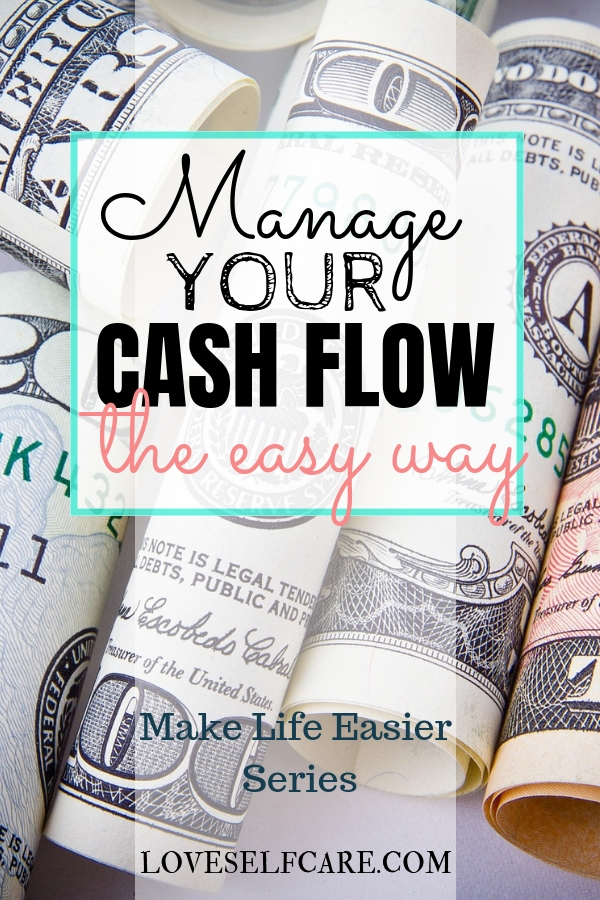
How to Create an Easy Way to Manage Your Cash Flow
What if I told you the secret to not bouncing checks personally is learning how to manage your cash flow? You can do it by taking care to of your money and stop living paycheck to paycheck. One of the top stresses for people is worrying about their finances and this is one step to help you conquer this aspect of your life.
There is a difference between how to manage cash flow and how to manage a budget. Budget is where you tell your money where to go and it is strongly encouraged to have a budget set up. See the article “Are Your Finances a Mess” for more information on how to do that. *I am not a financial expert. This is just a tool I have used to help manage our finances. See a financial expert if you have questions.
Cash flow is about what money you are going to have available for you and to pay your bills at any given time. If you don’t have a ton of money in your checking account, the idea of cash flow is obviously very important. Even if you do have money in your checking account, it is still important. You want to know what you have now cash flow wise. But, you also want to have a good idea of where you will be 6 months from now because that is the key to finally being free of living paycheck to paycheck.
**Scroll to the bottom to get your own version of the spreadsheet and see examples***
How do you manage your cash flow? Follow these Steps:
Step 1
Know your starting balance
Example $500 – money available in your checking account
Highly recommend you connect a savings account to your checking account for overdrafts
Also highly recommend you use online banking so you can know your balance at any given moment
Step 2
List your fixed bills on one side of the spreadsheet (house payment, utilities, credit card minimum payments, loan payments, etc.) – these are expenses that usually don’t change much each month.
Step 3
List your variable bills on the other side of the spreadsheet (budgeted items like groceries, dining, auto, clothing, etc.) – these are things you could adjust if you run out of money. A good online tracking system for your budgeted items would be “EveryDollar“, which is free.
Step 4
List your income by frequency of payment (for example, 2 times a month or 4 times a month and the amounts for each)
Step 5
Assign dates to the bills and dates to when you will actually be paid
Step 6
Total up the fixed bills
Step 7
Total up the variable bills
Step 8
Create a running total on the far right side
Step 9
Create a place for total income minus total expenses
Step 10
Create a spot for big expenses that come up
Step 11
Do the same thing for the next 5 months of the year (you can copy and paste, but make sure you adjust the dates for each month and review bills – fixed and variable)
Step 12
Carry the balance from the far right side to the starting balance on the next month
Step 13
As fixed bills are paid, update your sheet (this is also how you never forget a bill). Highlight when you have sent the check or it occurs online automatically. Bold the amount of that line when it has cleared your bank. As these come out of your account, update your far right total only
Step 14
As variable budget items are spent, you can highlight these as well. These items will probably just come out of the running total without you tracking it as much, but you should know when you have spent all of that line item. Also, if you are running out of money – don’t spend any more on the variable side! This way you won’t get overdrawn.
Step 15
As you or your spouse are paid, highlight these amounts as well
Step 16
Check your bank account balance daily so you always know where you are and what has cleared. This can also help you to know if anyone steals your account information.
Step 17
If you have a running debt you want to track, you can do that at the bottom as well. This will help you to know how you are making progress on paying down debt. Each month just update the total on the top line.
Step 18
You will want to adjust the far right number for your actual bank account balance – not just theoretical as time goes on. As you pay items, you can delete that portion from the far right columns, At the end of the month, the amount left gets put in the far right column beginning number again (or use your actual starting balance).
You Can Manage Your Cash Flow – Like a Boss!
This may seem hard at first, but it will eventually make sense. You will now know where you are at any given point plus you will be able to project out as to what your situation will be months from now. Let me know your thoughts about this system in the comments below!
Get your copy of the spreadsheet here! Make sure to create a copy before you start to edit it though!
Did you enjoy this post? If so, don’t forget to share it on Pinterest!

While you are here, make sure you grab your copy of the "Self-Care Mini-Guide" to help you figure out how to add self-care to your daily life. Just click the link Loveselfcare Self-Care Mini-Guide to download your guide!

[…] How to Create an Easy Way to Manage Your Cash Flow […]